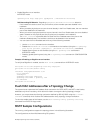
Influencing MSTP Root Selection
MSTP determines the root bridge, but you can assign one bridge a lower priority to increase the
probability that it becomes the root bridge.
To change the bridge priority, use the following command.
• Assign a number as the bridge priority.
PROTOCOL MSTP mode
msti instance bridge-priority priority
A lower number increases the probability that the bridge becomes the root bridge.
The range is from 0 to 61440, in increments of 4096.
The default is 32768.
Example of Assigning and Verifying the Root Bridge Priority
By default, the simple configuration shown previously yields the same forwarding path for both MSTIs.
The following example shows how R3 is assigned bridge priority 0 for MSTI 2, which elects a different
root bridge than MSTI 2.
To view the bridge priority, use the show config command from PROTOCOL MSTP mode.
R3(conf-mstp)#msti 2 bridge-priority 0
1d2h51m: %SYSTEM-P:RP2 %SPANMGR-5-STP_ROOT_CHANGE: MSTP root changed for
instance 2. My
Bridge ID: 0:0001.e809.c24a Old Root: 32768:0001.e806.953e
New Root:
0:0001.e809.c24a
R3(conf-mstp)#show config
!
protocol spanning-tree mstp
no disable
MSTI 1 VLAN 100
MSTI 2 VLAN 200,300
MSTI 2 bridge-priority 0
Interoperate with Non-Dell Bridges
The Dell Networking OS supports only one MSTP region.
A region is a combination of three unique qualities:
• Name is a mnemonic string you assign to the region. The default region name is null.
• Revision is a 2-byte number. The default revision number is 0.
• VLAN-to-instance mapping is the placement of a VLAN in an MSTI.
For a bridge to be in the same MSTP region as another, all three of these qualities must match exactly.
The default values for the name and revision number must match on all Dell Networking OS devices. If
there are non-Dell devices that participate in MSTP, ensure that these values match on all devices.
Multiple Spanning Tree Protocol (MSTP)
599


















